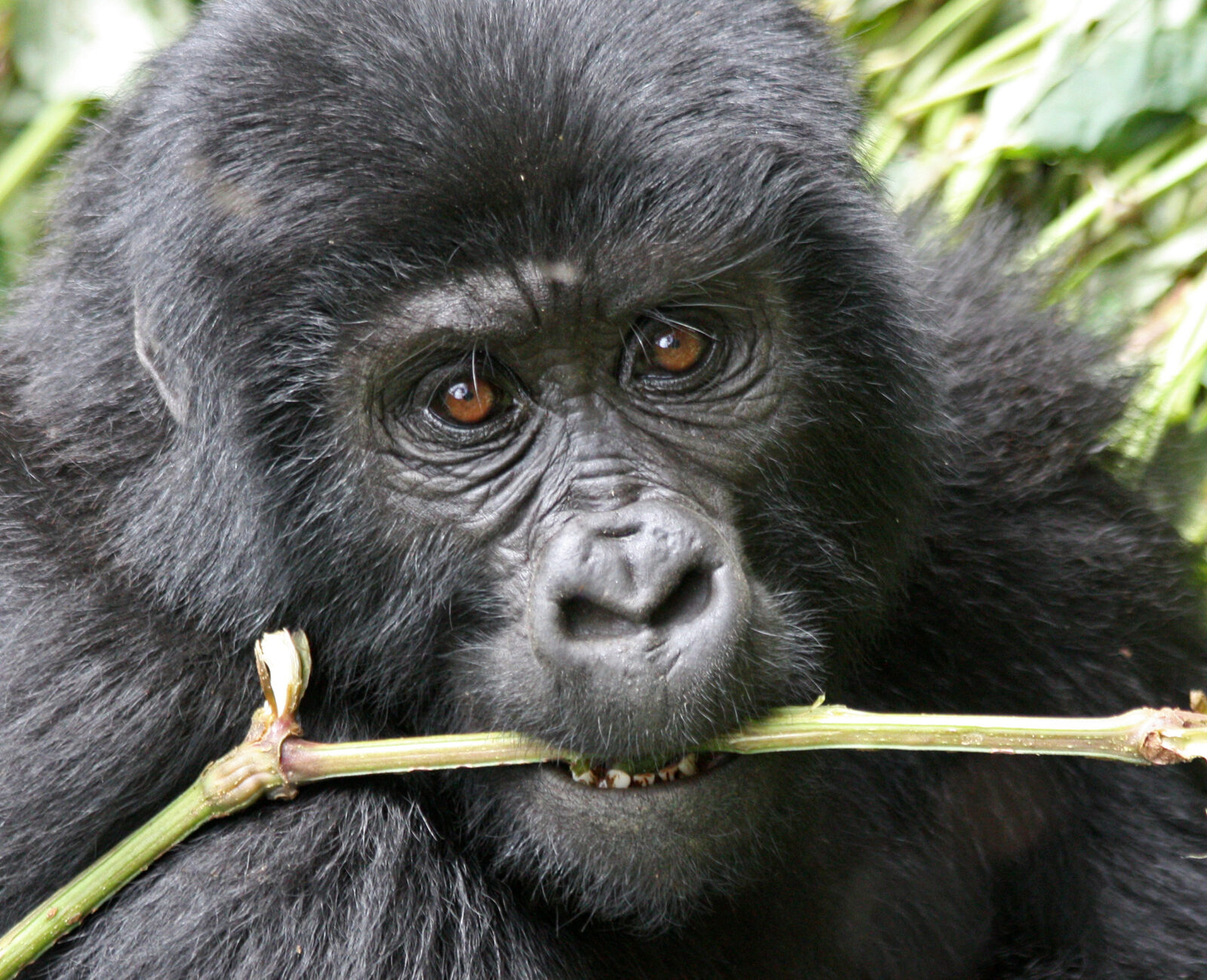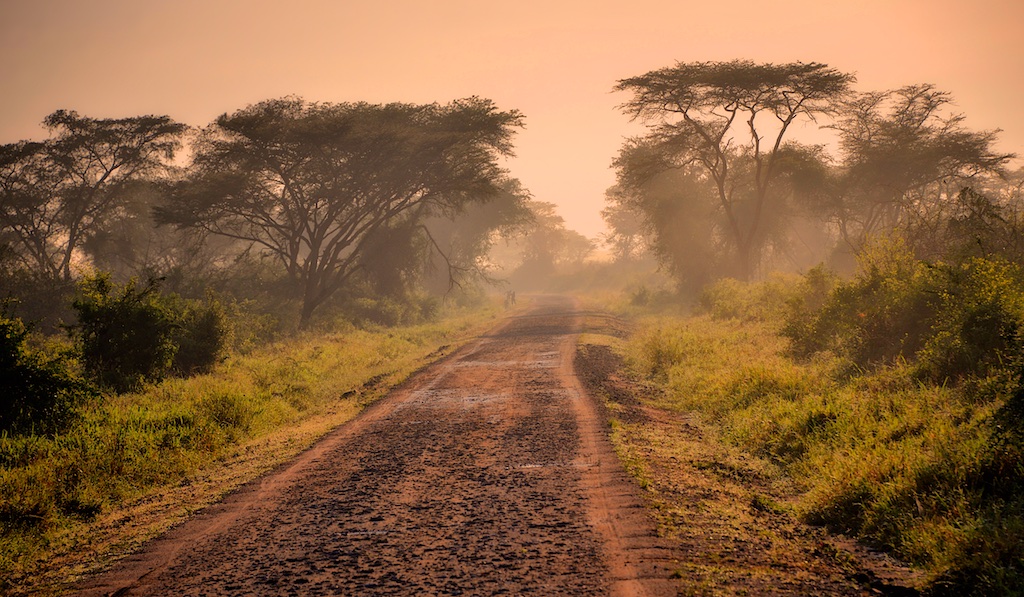Muhavura would be our last challenge.
Our next task would be Muhavura.For Karisimbi in the West, its 13,540-foot cone provided for an almost ideal bookend. Fortunately, much of the Ugandan section was buried in a recent lava flow that could not sustain gorillas, hence we did not have to risk an armed confrontation. Though we did not have to run the military sort of danger, our quick trips into the Ugandan section revealed little evidence of animals.
Though we did hear hunters employing dogs with bells, our quick trips into the Ugandan section revealed little evidence of wild animals. From below, twice bullets rang out. Though its slopes were high, hiking atop Muhavura was not too challenging; there were no major vegetal or physical obstacles.
Much of the bulk of the mountain was above the tree line, where an open steppe type habitat predominated. Brilliant red and green long-tailed malachite sun birds raced manically around this alpine moorland, their long, thin beaks suited like those of humming birds to sipping nectar. Northern double-collared sun birds flashed their metallic green and purple plumage. Bushbuck also grazed here, but he soon barked and ran on sight.
One day we found no gorillas and went to investigate the peak. We had to crawl over a tangle of twisted, moss-covered alpine senecio, a woody shrub spanning many generations to a height of ten to twelve feet, near the summit. In what seemed to be the biggest natural jungle gym in the world, this entangling labyrinth stretched hundreds of yards.

Our prize for passing was a perfectly spherical crater lake on top of Muhavura. The lake was only twenty yards wide, its surface barely eighteen inches from the edge. Bill laughed as he bent to sip from the cold black sources at the top of the planet, wondering whether it ever over flowed. In seconds clouds arrived and disappeared.
Clear times allowed us to view crowned fields of Rwanda to the South and lakes far to the North in Uganda. With clouds returning, a cold seeped beneath our skins. As the day came to an end, we grudgingly abandoned our watering place.
On Muhavura, our only gorilla interaction also happened to be the final census count. Late in one day we came across new gorilla signs. After backtracking to do two nest counts, we went back to notify the group and finish our count the next morning. Seven people—one silver back, two adult females, another unsexed adult, and three juvenile gorillas—were verified present.
Leading down hill, the fresh track of crushed herbs would pass the yellowed bones of a jackal, its foreleg still in the deadly grasp of a poacher’s wire trap. Not far away, the gorillas were audible. Bill approached till he came across a hand reaching into a bush about twenty feet distant. Then he ascended a tree to expose an elderly female’s face seated in a day nest eating gallium.
She looks back for about a minute, moving her head back and forth and allowing time for a nose print from a harsh gaze with reddish brow. She then runs softly behind those headed forward.By 13:10, dread muck is everywhere.
Common behaviors of wild gorillas when faced by people were silent flight and diarrhea. They also let us know when to go alone and do our last nest counts.
We traveled carefully counter clockwise around Muhavura for four more days till we arrived at the open lava field along the Eastern slope near the Rwanda-Uganda border. In that time, we traversed and investigated sixteen ravines, several of which harbored good gorilla habitat. Still, we never saw another gorilla or any evidence of any other animal save birds.
On Mt. Karisimbi, at the very western extremity of the park, we had observed the same kind of vacant environment. This ensured that the number of gorillas could continue grow. However, it also meant that these areas remote from the headquarters of the central park were killing grounds controlled by poachers where gorillas had been slaughtered. We left the park and headed down to an ancient colonial home at Gasinza, close to the foot of Mount Muhavura, late afternoon.
Though the mansion required paint and the foundation was crumbling, its scale, stone arches, and panoramic vistas suggested a more magnificent past. Now Drs. Alain and Nicole Montfort called home here. Belgian ecologists Alain and Nicole loved the Akagera National park in Eastern Rwanda savanna-wetland complex with a mild, dry climate.
Alain hated the hostile Virunga surroundings, but during his short stay in the North he had worked to enhance park security and administration. Alain and Nicole, hosts, got initial unofficial census results as well as other news from the forest. Mostly however, we delighted in delicious cuisine, fine wine, and great company. Bill delighted to utilize his considerably better French vocabulary after weeks of practical Swahili.
Solving conservation issues is like trying to put together a jigsaw puzzle for which the box has no picture; many components are missing and too little time to review all the surviving pieces. Our goal was to combine biological and social economic study to get the most comprehensive picture feasible. The census gave the initial bits to the very difficult jigsaw of how to better understand and safeguard the mountain gorillas.
Taking little over eight hours, the climb home from Gasiza to Karisoke covered around twenty-25 kilometers. There was plenty of time to consider what he had discovered and what it may entail for the gorillas. In 1959–1960 Georgr Schaller conducted the first Virunga census.A simmering civil conflict in Rwanda prohibited him from sampling certain locations, but his baseline figure of four hundred to five hundred people came from actual counts along with estimations based on habitat features.
A team of Karisoke scholars carried out the next census over three years, between 1971 and 1973.Their results revealed a sharp drop in average group size and proportion of young along with a corresponding fall in 300 to 275 gorilla count. Comparisons with the present figures swirled in Bill’s thoughts as he strolled over agricultural fields along the park boundary.
The good news was that, after its 1960s fast collapse, the population seemed to be stabilizing.Our lowest count was 252 people, which subsequently would be projected to represent 260,000 population.Better yet, the number of groups had dropped from thirty-one to twenty-eight, so we had discovered forty-two babies under three years old instead of only thirty-three in the same age class.
The bad news was that gorillas were clustering in the middle, particularly near Mount Visoke, and avoiding the Eastern and Western ends of the park. On Mt. Mikeno, where Schaller had tallied more than two hundred gorillas, there were only eighty-one.
Mts. Sabyinyo, Gahinga, and Muhavura backed only thirty-four gorillas in five groups. Objectively, it was at least a mixed message. Emotionally, it was a huge relief not to discover more losses, particularly in light of the tragic events of last year.


